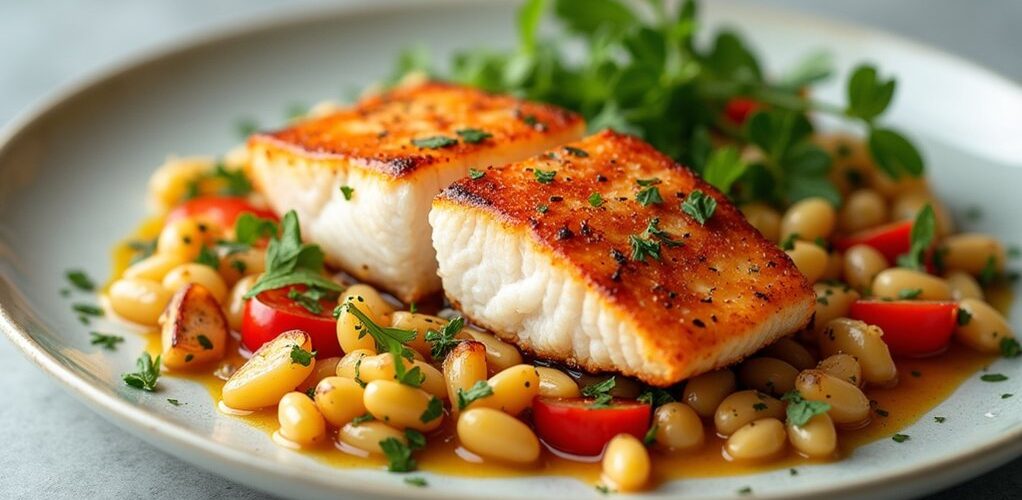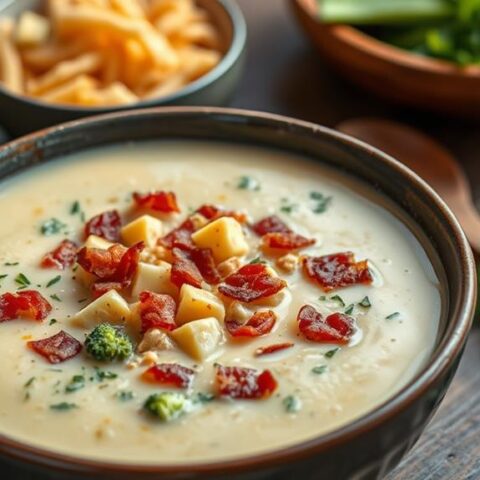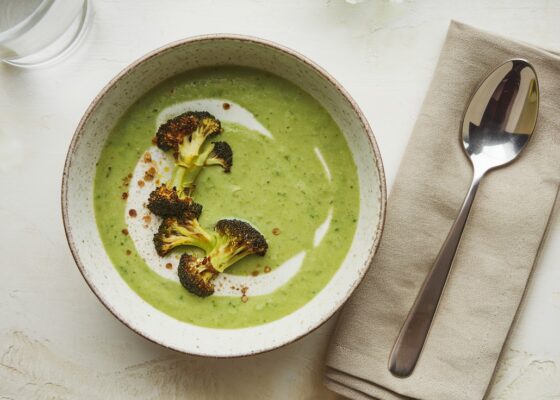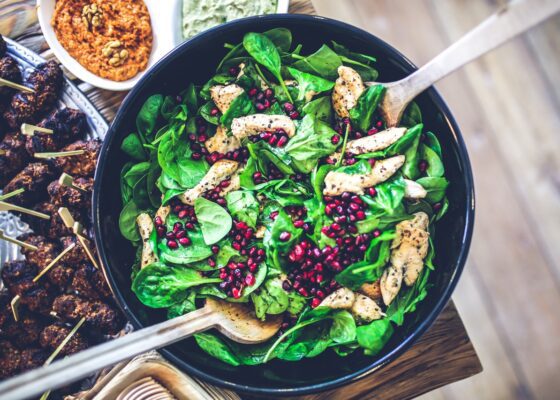
Fish is naturally low in carbohydrates, with most varieties containing zero to trace amounts per serving. Wild-caught fish, including salmon, cod, and halibut, offer substantial protein and healthy fats without adding carbs to one's diet. Shellfish varieties like shrimp and crab contain less than 1 gram of carbohydrates per 100 grams, while mussels and oysters average 4-5 grams. Proper preparation methods, such as grilling or baking with simple seasonings, help maintain fish's low-carb status while maximizing its nutritional benefits.
Key Takeaways
- Fish and seafood contain virtually no carbohydrates, making them ideal protein sources for low-carb and ketogenic diets.
- Most varieties of fish provide high-quality protein and healthy fats while containing less than 1 gram of carbs per serving.
- Shellfish like shrimp and crab are extremely low in carbs, while mussels and clams contain slightly more at 4-5 grams per serving.
- Unprocessed fish maintains its low-carb status, but breading, marinades, and sauces can add hidden carbohydrates.
- Wild-caught fish offers essential nutrients like omega-3 fatty acids, vitamin B12, and selenium without compromising low-carb goals.
Understanding Carbohydrates in Fish and Seafood
When considering low-carb dietary options, fish and seafood emerge as exceptional choices due to their minimal carbohydrate content. Nearly all varieties of fish contain negligible amounts of carbs while offering substantial protein and fat content, particularly beneficial for those following low-carb eating plans.
The carbohydrate profile of seafood makes it particularly valuable for maintaining strict carb limits while ensuring proper nutrition. Oily fish species, such as salmon and mackerel, deliver essential omega-3 fatty acids without adding to the daily carbohydrate count.
Similarly, shellfish varieties provide high-quality protein and healthy fats while keeping carbs at nearly zero. For ideal low-carb benefits, consumers should select whole, unprocessed fish and seafood products, as some processed alternatives may contain hidden carbohydrates through added sugars or other ingredients.
Top Low-Carb Fish Varieties for Your Diet
Wild-caught fish varieties, including salmon, cod, and halibut, offer excellent low-carb options while providing superior nutritional value compared to their farm-raised counterparts.
Fatty fish selections such as mackerel, sardines, and herring are particularly beneficial for ketogenic dieters due to their high omega-3 content and nearly zero carbohydrates.
These nutrient-dense options can be prepared through various cooking methods, from grilling to baking, while maintaining their low-carb status and offering versatile meal possibilities.
Wild-Caught Fish Options
The selection of wild-caught fish provides numerous options for those following a low-carb diet, with varieties like salmon, mackerel, and sardines offering virtually zero carbohydrates while delivering essential nutrients.
These naturally low carbohydrate choices are rich in omega-3 fatty acids and high-quality protein, making them excellent additions to a carb-conscious meal plan.
White fish varieties, such as cod and halibut, present equally beneficial low-carb alternatives, while shellfish options including shrimp and mussels contribute valuable vitamins and minerals to the diet.
By choosing wild-caught fish, consumers not only support sustainable fishing practices but also guarantee they're getting nutrient-dense seafood that aligns perfectly with their dietary goals.
These natural, unprocessed options provide clean protein sources without the added sugars often found in processed foods.
Fatty Fish For Keto
Among fatty fish varieties, several standout options prove particularly valuable for those following a ketogenic lifestyle. Salmon, mackerel, and sardines offer exceptional nutritional profiles while containing virtually no carbohydrates, typically 0-1 grams per serving.
These protein-rich options are ideal for maintaining ketosis while providing essential omega-3 fatty acids.
Salmon leads the pack with its impressive array of nutrients, including vitamin D, selenium, and B vitamins, making it a superior choice for keto dieters.
Mackerel, though often overlooked, delivers similar benefits and can be prepared through various low-carb cooking methods.
For optimal health advantages while adhering to a ketogenic diet, incorporating these fatty fish options at least twice weekly can help maintain nutritional balance and support both heart and brain function.
Health Benefits of Including Fish in a Low-Carb Diet
Including fish in a low-carb diet offers considerable health benefits that extend far beyond basic nutrition. Fish and seafood naturally contain minimal carbohydrates while providing essential omega-3 fatty acids, which contribute greatly to heart health and help reduce inflammation throughout the body.
The high protein content in fish varieties like salmon, mackerel, and sardines promotes satiety and helps maintain muscle mass during weight loss efforts.
Additionally, fish provides vital vitamins and minerals, including B12, vitamin D, and selenium, supporting overall health and metabolic function. These nutrients work synergistically in a low-carb diet to enhance energy levels and promote ideal bodily functions, making fish an invaluable component of a well-rounded nutritional approach.
Best Cooking Methods to Keep Fish Low-Carb
Grilling fish directly on the barbecue creates a flavorful, low-carb meal without introducing unnecessary carbohydrates through added ingredients.
Pan-searing fish in healthy fats like olive oil or butter offers another excellent method for maintaining its naturally low-carb composition while developing a crispy exterior and tender interior.
These cooking techniques, when paired with simple seasonings such as herbs, spices, or lemon juice, guarantee the fish remains both carb-conscious and appetizing without sacrificing taste or nutritional value.
Grilling Without Added Carbs
When it comes to maintaining a low-carb diet, preparing fish on the grill stands out as one of the most effective cooking methods available. Grilling naturally enhances the fish's flavor without introducing additional carbohydrates, while the high cooking temperatures create a delicious crust that seals in moisture and nutrients.
To maximize the low-carb benefits of grilling, incorporate healthy fats like olive oil or avocado oil, which add richness without contributing carbohydrates. Rather than using sugar-laden marinades, enhance flavor with carb-free seasonings such as fresh herbs, spices, and citrus zest.
The grilling process pairs perfectly with low-carb side dishes, particularly grilled vegetables like asparagus or leafy greens, creating a complete meal that maintains strict carbohydrate restrictions while delivering exceptional taste.
Pan-Searing for Best Results
While grilling offers excellent low-carb cooking options, pan-searing presents another powerful method for preparing fish without adding carbohydrates. This technique involves quickly cooking fish in a preheated pan with a small amount of high-smoke point oil, creating a perfectly crispy exterior while maintaining a tender interior.
Using healthy fats like avocado or coconut oil enhances the natural flavors of fish while keeping it completely carb-free.
Pan-searing works exceptionally well with various fish species rich in omega-3 fatty acids, such as salmon, cod, and mackerel, making it an ideal choice for low-carb diets. The key to successful pan-searing lies in properly preheating the pan, which locks in moisture and creates the desired texture without requiring additional ingredients that might introduce unwanted carbohydrates.
Shellfish and Their Carbohydrate Content
Most shellfish varieties are remarkably low in carbohydrates, making them an ideal choice for those following low-carb dietary plans. Shrimp, crab, and lobster contain less than 1 gram of carbohydrates per 100 grams, positioning them among the lowest-carb protein sources available.
While mussels, clams, and oysters contain slightly more carbohydrates, averaging 4-5 grams per 100 grams, they still maintain a relatively low carb profile compared to other food options.
The minimal carbohydrate content in shellfish comes primarily from glycogen, which has a negligible impact on overall carb intake. For individuals seeking to maintain a low-carb lifestyle while ensuring adequate protein intake, shellfish serve as an excellent nutritional choice, offering essential nutrients without compromising dietary goals.
Selecting and Storing Fish for Low-Carb Meals
Successful low-carb meal preparation begins with careful fish selection and proper storage techniques.
Smart fish selection and proper storage are essential foundations for creating delicious, carb-conscious meals that support your dietary goals.
When selecting fish, opt for fresh, wild-caught varieties over farmed options to maximize nutritional benefits while avoiding hidden carbohydrates. Fresh fish should be stored in the refrigerator's coldest section and consumed within two days, or frozen for extended storage.
For frozen fish, choose products in vacuum-sealed packaging without added sauces or coatings that might contain carbohydrates.
When purchasing canned tuna or other preserved fish, select varieties packed in water or olive oil, avoiding options with added sugars or preservatives. Store unopened cans in a cool, dry location to maintain quality.
Always check labels carefully for hidden ingredients that could compromise low-carb dietary goals, particularly in pre-seasoned or processed fish products.
Common Mistakes When Eating Fish on a Low-Carb Diet
Careful fish selection and storage practices set the foundation for low-carb meals, but even well-chosen fish can lead to dietary missteps. Many people unknowingly compromise their low-carb goals by consuming processed fish products with hidden carbohydrates, such as breaded fillets or fish sticks coated in starchy ingredients. Another common error occurs when selecting canned fish products without checking labels for added sauces or flavorings that increase carb content. It's crucial to avoid high-carb condiments like barbecue sauce or sweet and sour sauces when preparing fish. While the fish itself may be naturally low in carbohydrates, accompanying side dishes like rice or pasta, along with sugar-laden sauces such as teriyaki or sweet chili, can greatly impact overall carb intake. To maintain a low-carb eating plan, opt for fish prepared with healthy fats instead of starchy marinades, and pair with non-starchy vegetables.
Meal Planning With Fish for Low-Carb Success
When incorporating fish into a low-carb meal plan, strategic preparation and thoughtful pairing choices can lead to satisfying and nutritious meals that align with dietary goals. For those following a ketogenic diet or healthy diet focused on reduced carbohydrates, fish provides an ideal protein foundation that supports nutritional requirements while maintaining low-carb status. Protein synthesis maintains amino acid balance crucial for muscle maintenance and recovery.
| Meal Type | Fish Option | Low-Carb Side |
|---|---|---|
| Breakfast | Smoked Salmon | Avocado |
| Lunch | Grilled Mackerel | Spinach Salad |
| Dinner | Baked Cod | Roasted Broccoli |
| Snack | Sardines | Cucumber Slices |
Success in low-carb meal planning with fish comes from combining various cooking methods with complementary vegetables and ensuring proper portion sizes. This approach provides sustained energy while maintaining ketogenic requirements and supporting overall health goals.
Pairing Fish With Other Low-Carb Foods
Creating delicious and satisfying low-carb meals centers on skillfully pairing fish with complementary ingredients that maintain minimal carbohydrate content while maximizing nutritional value. Leafy greens and cruciferous vegetables serve as excellent accompaniments, providing essential nutrients without significant carbs. Incorporating healthy fats through olive oil, avocados, nuts, and seeds not only enhances flavor but also increases meal satiety. For ideal nutritional balance, low-sugar fruits like berries can be included alongside fish dishes, while herbs and spices add depth of flavor without contributing carbohydrates. These thoughtful pairings guarantee that fish-based meals remain low-carb while delivering a complete spectrum of nutrients. When combined strategically, these ingredients create satisfying dishes that support dietary goals while maintaining variety and taste. Including keto-friendly vegetables like spinach, kale, and broccoli can further enhance the nutritional profile of your meals while aligning with a low-carb diet.
Navigating Restaurant Fish Dishes on a Low-Carb Diet
Dining out while maintaining a low-carb lifestyle requires diners to navigate restaurant fish dishes with strategic awareness and informed choices.
When following a low-carb diet, understanding different preparation methods and ingredient additions becomes essential for making informed decisions about fish dishes at restaurants.
- Select grilled, broiled, or steamed fish options without breading or sugary sauces to maintain low carb counts.
- Request shellfish dishes prepared with simple ingredients like garlic butter instead of cream-based or sweetened sauces.
- Ask servers about marinades and cooking methods, as hidden carbohydrates often lurk in restaurant preparations.
- Conduct menu research online to spot keto-friendly fish dishes before dining out.
Diners can successfully maintain their low-carb goals by choosing fish dishes thoughtfully and requesting modifications when needed.
Simple preparations of salmon, cod, or shellfish typically offer excellent low-carb options, while avoiding breaded items and carefully considering sauce choices.
Tracking Carbs in Fish-Based Recipes
Tracking carbohydrates in fish-based recipes requires careful attention to accompanying ingredients and preparation methods, as the fish itself typically contributes minimal carbs to the final dish.
Fish provides a naturally low-carb foundation, but side ingredients and cooking methods can significantly impact the total carbohydrate content of seafood dishes.
While fresh fish and shellfish are excellent choices for low-carb diets, hidden carbs can appear in sauces, marinades, and breading used during preparation.
For accurate tracking, cooks should carefully review nutritional labels on all ingredients, particularly processed or pre-packaged seafood products that may contain added sugars.
When following recipes, it's essential to calculate the total carbohydrate content by considering each component separately. This includes checking carb counts in seasonings, breadcrumbs, and any accompanying sauces.
It's crucial to choose high-quality fats, such as those from avocados and olive oil, to ensure that your low-carb, fish-based recipes contribute positively to overall heart health.
Frequently Asked Questions
Which Fish Is Lowest in Carbs?
Most types of fish, including salmon, tuna, and cod, contain zero carb content naturally. These seafood options offer excellent fish benefits while maintaining virtually no carbohydrates in their pure, unprocessed form.
What Is the Number One Carb to Avoid?
Refined sugar stands as the most detrimental carbohydrate to avoid, commonly hidden in processed foods. Unlike sugar alternatives, it causes rapid blood sugar spikes and offers no nutritional value compared to grain products or starchy vegetables.
Is Salmon Good for a Low Carb Diet?
Salmon's nutritional profile makes it ideal for low-carb diets, offering protein and healthy fats. Various salmon cooking methods provide versatility, while its health benefits support well-being. Salmon meal prep guarantees convenient low-carb options.
Is Fish Allowed on the Keto Diet?
Fish is highly keto-friendly, offering essential nutrients and healthy fats. Various cooking methods, from grilling to baking, preserve its health benefits while supporting ketosis. Choosing sustainably-caught options guarantees environmental responsibility.
Conclusion
Fish serves as an excellent foundation for any low-carb eating plan, with most varieties containing virtually no carbohydrates while delivering essential proteins and healthy fats. By selecting fresh fish, employing simple cooking methods, and pairing it with low-carb vegetables, anyone can create satisfying meals that align with their dietary goals. Whether dining out or cooking at home, fish offers a versatile, nutrient-rich option for maintaining a successful low-carb lifestyle.










No Comments